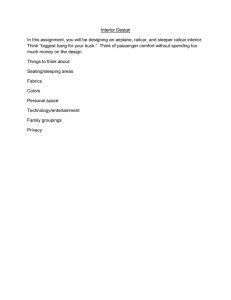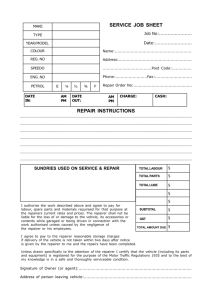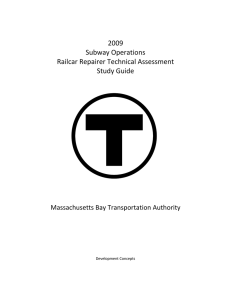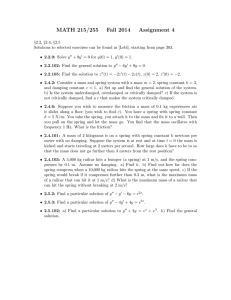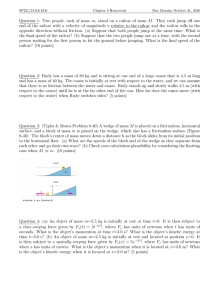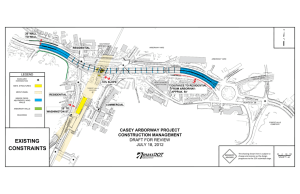- MBTA.com
advertisement
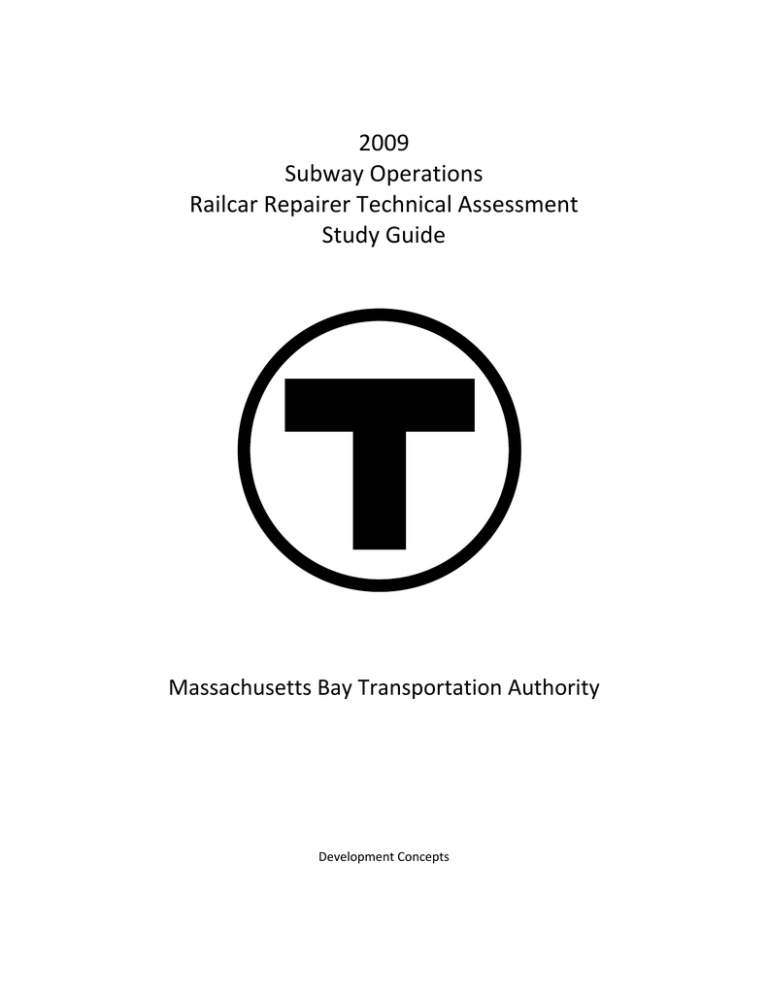
2009 Subway Operations Railcar Repairer Technical Assessment Study Guide Massachusetts Bay Transportation Authority Development Concepts MBTA Subway Operations Railcar Repairer Technical Assessment 2009 Study Guide page 2 Introduction This Study guide is being provided by the MBTA to help potential candidates for the Railcar Repairer position understand the specific technical knowledge requirements of the position and to help them prepare for the Railcar Repairer Technical Assessment, which is part of the selection process for the Railcar Repairer position. Background A Railcar Repairer performs highly skilled technical services involving the inspection, troubleshooting and repair of all electrical, electronic and mechanical equipment on MBTA heavy and light rail vehicles and performs other related duties as required. Major responsibilities of the Railcar Repairer are to: Perform preventive and corrective maintenance as well as inspect, service, adjust, calibrate, align, and diagnose all electronic, high and low voltage electrical and mechanical systems, propulsion, printed circuit boards, microprocessors, amplifiers, logic gates, operation of thyristors, various applications of capacitors, relay switches, logic, static converter for regulation, motors, trucks, pneumatic‐hydraulic brakes, compressors, generating heat and air conditioning and other car related components to ensure optimum operating efficiency consistent with design requirements. Connect and operate electronic, electrical and mechanical diagnostic test equipment to determine proper function and detect potential malfunction to assure prescribed performance. Troubleshoot and solve unusual and complex equipment malfunctions, determine and make corrective repairs by applying working knowledge and understanding of all electronic, electrical and mechanical equipment, technical publications, wiring diagrams, test techniques and blueprints. The Study Guide outlines by knowledge area specific topics that are important for a Railcar Repairer to know in order to successfully complete the responsibilities of the job. These same knowledge areas and topics are the basis for the Railcar Repairer Technical Assessment. Sufficient knowledge of these areas and topics should improve a candidate’s potential for passing the Railcar Repairer Technical Assessment. Development Concepts MBTA Subway Operations Railcar Repairer Technical Assessment 2009 Study Guide page 3 Content Review Safety General Tag‐Out Lock‐Out Pinch Points Confined Spaces Personal Protective Equipment Eye Protection Hearing Protection Steel‐toed Shoes Protective Headgear Clothing – Safe / Unsafe MSDS Material Safety Data Sheets (MSDS) • What are they? • What safety information do they contain? Electrical Safety De‐energizing the potential energy in electrical circuits, such as capacitors and batteries. Using GFI (ground fault interruption) circuits to power equipment when working in wet environments. Working with and near high voltage electrical systems. Development Concepts MBTA Subway Operations Railcar Repairer Technical Assessment 2009 Study Guide page 4 Mechanical Safety Pinch Points De‐energizing the potential energy stored in mechanical systems in the form of pressurized fluids (gases, liquids), rotational energy or due to gravity (loads being able to fall). Safe lifting and rigging of loads. Fire Safety Class A, B, C fire extinguishers and their proper uses. Development Concepts MBTA Subway Operations Railcar Repairer Technical Assessment 2009 Study Guide Electrical DC Basics Voltage • Definition Current • Definition Resistance • Definition Power • • P = I*V P = I2*R Ohm’s Law • Definition Resistors • • • Series Circuits Parallel Circuits Typical applications Capacitors • • How do they work? Function in a circuit / typical applications Inductors • • How do they work? Function in a circuit / typical applications Simple Circuits • • Voltage Measurements between points / components Current Measurements between points / components Development Concepts page 5 MBTA Subway Operations Railcar Repairer Technical Assessment 2009 Study Guide AC Basics AC Basics • • • • Alternating current Frequency Peak voltage RMS voltage Transformers • • • • Basic electro‐magnetic theory Induced current flow Transformer types – step up / step down Ratios Circuit Components Switches & Relays • • • • • • • Normally‐open, Normally‐closed switches Limit switches Relays Pressure Switches Solenoids Rotary Cam switches Rotary switches Sensors • • • • Pressure Transducers Hall effect sensors Proximity Sensors Optical Sensors Other Devices • • • • Optical Couplers Encoders LEDs Fluorescent Light Systems o Troubleshooting failures Development Concepts page 6 MBTA Subway Operations Railcar Repairer Technical Assessment 2009 Study Guide Batteries • • • • • • Cables / Connections Battery condition Specific Gravity Charging Safe disconnection Troubleshooting Basic Electronics Semiconductors – definition Diodes – definition and function • • • Diode current flow in a circuit Voltage drop across a diode Full wave / Half wave bridge Inverters / Rectifiers • • Block Diagram Operation SCR / IGBT / GTO Devices Pulse width modulation Electrostatic Discharge prevention Printed Circuit Board • • • Safe handling practices Multi‐layer Surface Mount Development Concepts page 7 MBTA Subway Operations Railcar Repairer Technical Assessment 2009 Study Guide Instrumentation & Measurement Voltmeters • • • What is a voltmeter? Voltage ranges How is a voltmeter connected to a circuit? Ammeters • • • What is an ammeter? Types of ammeters / match to application How is an ammeter connected to a circuit? Ohmmeters • • • What is an ohmmeter? How is an ohmmeter connected to a circuit? How is an ohmmeter used to check motor winding integrity? Digital Multimeters • • • What is a digital multimeter (DMM)? Scale selection Continuity measurement Oscilloscopes • • • What is an oscilloscope? How is it typically used? What are typical waveforms observed? Infrared Imaging / Thermography • • What is infrared imaging / thermography How is it typically used?? Meggers • • What is a Megger? How is it typically used? Development Concepts page 8 MBTA Subway Operations Railcar Repairer Technical Assessment 2009 Study Guide Digital Controls Input / Output (I/O) • • • • • Component identification from input/output schematics Typical digital inputs, outputs Typical analog inputs, outputs Basic input/output schematic understanding Discrete Output operation and wiring Ladder Logic (LL) • • • • Boolean gate logic Boolean gate logic operations Logic operation from ladder logic schematics and symbols Basic Ladder Logic understanding Motors AC / DC Motors • • • • • • Differences / advantages between AC / DC motors AC Motor components and function o Single phase o Three phase DC Motor components and function Rotation direction changes (AC / DC) Basic motor troubleshooting Control voltage versus load voltage Motor Control Circuits • • • • Motor control schematics Motor acceleration control (resistance based) Variable Frequency Drive basics o Block diagram o Troubleshooting Regenerative, dynamic braking Development Concepts page 9 MBTA Subway Operations Railcar Repairer Technical Assessment 2009 Study Guide Wiring & Connections Conductors • • • • • Labeling Stripping / preparation Size vs Load considerations Resistance / Losses Failure modes Connectors • • • • • • Types and selection Mechanical lug terminations Crimped multi‐pin connectors Wire termination preparation & tools Crimping & tools Soldering & fluxes Hand Tools Normal hand tool use Fuse Pullers Wire Strippers Crimpers Wire Cutters Development Concepts page 10 MBTA Subway Operations Railcar Repairer Technical Assessment 2009 Study Guide page 11 Schematics Circuits • • • Identification of purpose or function Sequence of operation of a circuit: if / then situations (if “X” are the conditions, and you do “Y”, then what happens?) Anticipated Voltage Readings at circuit connection points Symbols • • • • • ANSI / ISO Standard Symbols Motors Inputs – switches (pressure, flow, temperature, limit, etc.) Outputs – motors, pumps, fans, solenoids Power sources / controls – batteries, disconnects, contactors, fuses, knife switches PC Computer Skills Hardware – Cable Connections Software • • • Browser Commands File Menu Structure Mouse Commands Development Concepts MBTA Subway Operations Railcar Repairer Technical Assessment 2009 Study Guide Mechanical Measurement and Tools Rulers • Use Micrometers • • • Types Selection and use Measurement techniques Calipers • • • Dial Digital Measurement techniques Go / No‐Go Gages • • Function Applications Hand Tools • • • • Function Selection and use Torque Wrenches Surface cleaning (abrasive pads, sandpaper, etc.) Power Tools • • • Pneumatic tools (impact wrenches, ratchets) Electric Drill / Drill Presses Bench Grinders / Right Angle Grinders Development Concepts page 12 MBTA Subway Operations Railcar Repairer Technical Assessment 2009 Study Guide Fluid Power (Hydraulics and Pneumatics) Theory • • • Differences between liquids (hydraulics) and gases (pneumatics) Stored (potential) energy Force calculation (pressure times area) Pumps • • Common terms Common pump types Components • • Cylinders Pressure Gauges Valves & Flow Control • • • • • • Directional control valves Pressure regulation valves (control and relief) Flow control valves o Meter in / Meter out Check valves Valve operation and effect on fluid flow Orifice Plates Piping, Tubing and Connections • • • • Pipe types Tubing types Connections / Components (Pipe and Tubing) o Types o Selection and use Assembly techniques o Crimping o Threading o Flaring o “Swagelok” Development Concepts page 13 MBTA Subway Operations Railcar Repairer Technical Assessment 2009 Study Guide Mechanical Systems & Components Fasteners • • • • • • • Fastener types, selection and use Fastener grades and fit Screw threads o Pitch o Internal / External, Coarse / Fine threads Torquing and pre‐loading Methods of locking fasteners Shear pins Specialty fasteners – ¼ turn devices Lubrication • • • • • • Lubrication principles o Purpose o Viscosity, flash point and pour point Types of lubricants o Oils / greases Lubricant selection and use, including compatibility Application methods o Oils / greases Factors affecting lubricant performance Other materials: anti‐seize; spray lubricants Seals • • • • Lip Seals function and installation O‐ring selection and use Gasket removal, installation and use Shaft seals Couplings • • • • Types Selection and use Shaft preparation / installation / removal Purpose of alignment Development Concepts page 14 MBTA Subway Operations Railcar Repairer Technical Assessment 2009 Study Guide Belts & Pulleys • • Types / sizes Selection and use • Troubleshooting Bearings • • • • Types Selection and use Installation and removal techniques Troubleshooting typical problems Gearboxes • • Components Troubleshooting Lead Screws / Ball Screws • • Operation Troubleshooting Material Handling & Rigging Rigging • • Load balancing Calculation of load center of gravity Slings – usage and loading • Wear indications – slings, wire rope, chain, hooks Fork Truck Operation • Safe loads, capacity Air Compressors & Driers Components Operation Troubleshooting Development Concepts page 15 MBTA Subway Operations Railcar Repairer Technical Assessment 2009 Study Guide page 16 Air Conditioning Systems Components Schematic of basic flow Troubleshooting Refrigerant Charts (Type, Temperature, Pressure) Oxyacetylene Cutting and Welding Theory of combustion Gas set‐up and operation Torch set‐up and operation Troubleshooting Schematics Hydraulic and Pneumatic Circuits • • Identification of purpose or function Sequence of operation of a circuit: if / then situations (if “X” are the conditions, and you do “Y”, then what happens?) Symbols • • • • Pumps Valves Motion Devices (cylinders, actuators, etc.) Auxiliary Devices (receivers, dryers, heat exchangers, etc.) Print Reading & Instructions/Procedures • • Data acquisition from prints and instructions Reading and comprehension of instructions and procedures Development Concepts MBTA Subway Operations Railcar Repairer Technical Assessment 2009 Study Guide page 17 Troubleshooting / Problem‐Solving Cause & Effect The nature of troubleshooting is understanding that problems occur because specific events have taken place. What we usually observe when we come to the scene of a problem are the results or the effects of something that happened – many times we do not or can not immediately observe what caused the problem originally. In some instances, the effects of the root (“original”) cause are repaired and then later occur again because the underlying root cause was not determined and repaired. Care must also be taken to determine all of the causes of a problem, for in many instances there may be several important causes. The ability to troubleshoot effectively (quickly and accurately) is prized by employers the world over. This skill is usually dependent upon a certain level of experience with the equipment, system or processes that require troubleshooting. However, having an understanding of the techniques and methods of troubleshooting can give anyone an improved opportunity to solve problems quickly and accurately, even without extensive experience with the problem equipment. Some steps and methods that can be helpful are: • Condition assessment ‐ what does the physical evidence mean? • Linking the physical evidence to probable causes. • Investigating the probable causes to determine if they were contributors to the problem. • Determining the root cause(s). • Use of a Cause & Effect diagram (“fish bone” diagram) to ensure that all potential causes were considered. • Use of “5 Whys” o If you ask “why did this happen” enough times, it will lead you to the root cause. For example, a shaft has broken: o “Why (1) has it broken?” It was subjected to extreme stress because of misalignment. “Why (2) was it subjected to misalignment?” Because the pillow block bearing at one end had shifted. “Why (3) did the bearing shift?” Because the bolts holding it in place failed. “Why (4) did the bolts fail?” Because improper bolts (ungraded versus grade 5) bolts were used. “Why (5) were ungraded bolts used?” The repair procedure did not specify the correct bolt type. You can then correct the repair procedure, use grade 5 bolts to retain the bearing and prevent the replacement shaft from failing in the same manner. Development Concepts MBTA Subway Operations Railcar Repairer Technical Assessment 2009 Study Guide page 18 Reference Materials Listed below are books and web sites that may be of use in preparing for the Railcar Repairer position. The books, in general, are listed in order of helpfulness and all are available through Amazon.com or Borders Bookstores. The information provided is the book title (underlined), the book’s author (or editor) and the book’s ISBN number (international identification number – any bookstore can identify a book by its ISBN number) – it is easy to search on Amazon, for example, by the ISBN number alone. The web sites all have relevant information that can be helpful in understanding real‐world situations and solutions. Books Audel Millwrights and Mechanics Guide Thomas B. Davis, Carl A. Nelson ISBN 978‐0764541711 Audel Welding Pocket Reference James E. Brumbaugh, Rex Miller ISBN 978‐0764588099 Audel Electrical Course for Apprentices and Journeymen Paul Rosenberg ISBN 978‐0764542008 Modern Refrigeration and Air Conditioning Andrew D. Althouse, Carl H. Turnquist and Alfred F. Bracciano ISBN 978‐1590702802 Industrial Mechanics and Maintenance Larry Chastain ISBN 978‐0135150962 Fundamentals of Electronics Circuits and Devices, 4th Edition Russell L. Meade ISBN 978‐1418005382 Mechanical Trades Pocket Manual, 3rd Edition Carl A. Nelson ISBN 978‐0025886650 Development Concepts MBTA Subway Operations Railcar Repairer Technical Assessment 2009 Study Guide IPT’s Electrical Training Manual, Spiral Bound Edition Herb Putz ISBN 978‐0920855249 Development Concepts page 19 MBTA Subway Operations Railcar Repairer Technical Assessment 2009 Study Guide Web Sites GENERAL REFERENCE Wikipedia – Online encyclopedia http://en.wikipedia.org/wiki/Main_Page WikiHow – Online encyclopedia of how to do things http://www.wikihow.com/Main‐Page GENERAL MAINTENANCE Plant Engineering, Maintenance and Reliability Resources http://www.maintenanceresources.com/ Plant Maintenance Resource Center www.plant‐maintenance.com Maintenance World http://www.maintenanceworld.com/ MECHANICAL Bearings Timken Bearing Knowledge Center http://www.timken.com/en‐us/knowledge/Pages/default.aspx How Stuff Works – Bearings http://science.howstuffworks.com/bearing3.htm Wikipedia Entry http://en.wikipedia.org/wiki/Ball_bearing Seals Wikipedia Entry, with links to vendor sites http://en.wikipedia.org/wiki/Radial_shaft_seal Gasket replacement http://www.automedia.com/Engine_Gasket_Replacement/ccr20011101eg/1 Development Concepts page 20 MBTA Subway Operations Railcar Repairer Technical Assessment 2009 Study Guide page 21 Power Transmission How gears work. http://science.howstuffworks.com/gear.htm Wikipedia section on Gears http://en.wikipedia.org/wiki/Gears Gates Industrial Power Transmission http://www.gates.com/index.cfm?location_id=534 Gates Belt Drive Maintenance Manual http://www.gates.com/campaignPM/index.cfm?go=btgtspm1103&CFID=5454292&CFTOKEN=13755298 Fluid Power Fundamentals of Pneumatics http://www.nfpa.com/Education/Edu_LearningOpps_SelfPacedFundamentalsPneumatic.asp Fundamentals of Hydraulics http://www.nfpa.com/Education/Edu_LearningOpps_SelfPacedFundamentalsHyd.asp How Hydraulics Work ‐ Basic http://science.howstuffworks.com/hydraulic1.htm Parker Hydraulics – search for Service Manuals http://www.parker.com/portal/site/PARKER/menuitem.eb20258a5093aeecb1935b1076108a0c/?vgnext oid=5a2880961f66e010VgnVCM1000000308a8c0RCRD&vgnextfmt=default#results Gates Hose; to get the really good stuff, you need to establish a user name and password, using basic personal information. • Gates Industrial Hose Catalog • Gates Hydraulic Catalog • White Papers http://gatesprograms.com/mobileequipment Swagelok gaugeable tube fittings http://www.swagelok.com/downloads/webcatalogs/en/ms‐01‐140.pdf Swagelok tube fitting resources http://www.swagelok.com/search/find_resources.aspx Development Concepts MBTA Subway Operations Railcar Repairer Technical Assessment 2009 Study Guide page 22 Tools Stanley Tool – Tool Use (basic) http://www.stanleytools.com/default.asp?TYPE=STATICLEFT&PAGE=tooltips.htm&LEFT=left_tooltips.htm Do‐It‐Yourself – Hand tool use (basic) http://www.doityourself.com/scat/handtools eHow website – Safe hand tool use (basic) http://www.ehow.com/how_2337754_safely‐use‐basic‐hand‐tools.html Snap‐On Tools (descriptions) http://buy1.snapon.com/catalog/catalog.asp Snap‐On Tools – Other websites http://www.snapon.com/othersites.asp How to use basic shop machine tools http://web.mit.edu/2.670/www/Tutorials/Machining/Description.html Air Conditioning EPA website for service technicians http://www.epa.gov/ozone/title6/609/technicians/index.html WikiHow – Air conditioning http://www.wikihow.com/Fix‐Your‐Car's‐Air‐Conditioner Welding / OAC Hobart e Learning center http://www.hobartwelders.com/elearning/ Reference Library of Articles on a wide variety of topics. OK reading, but not comprehensive. http://www.maintenanceresources.com/referencelibrary/index.htm Wikipedia entry for Oxygen‐Acetylene welding and cutting http://en.wikipedia.org/wiki/Oxy‐fuel_welding_and_cutting Development Concepts MBTA Subway Operations Railcar Repairer Technical Assessment 2009 Study Guide page 23 ELECTRICAL Excellent content on electrical/electronic topics, based upon question and answers. • Basic Electricity • DC Electric Circuits • AC Electric Circuits • Network analysis techniques: • Discrete semiconductor devices and circuits: • Analog Integrated Circuits • Digital Circuits • Mathematics for Electronics • Circuit Animations • Math Animations http://www.openbookproject.net/books/socratic/doc/topical.html Another group of online texts covering electrical/electronics fundamentals: • Volume 1 DC Volume 2 AC • Volume 3 Semiconductors • Volume 4 Digital • Volume 5 Reference • Volume 6 Experiments http://openbookproject.net/electricCircuits/ Circuit Diagrams – Wikipedia entry http://en.wikipedia.org/wiki/Circuit_diagram Rockwell Automation Literature Library http://literature.rockwellautomation.com/idc/groups/public/documents/webassets/browse_category.h cst SquareD Technical Library http://ecatalog.squared.com/techlib/ EC&M Training http://ecmweb.com/training/ Crane Controls The Electric Controller and Manufacturing Company – Crane Controls, but good basic information on electrical controls http://www.ecandm.net/Support.aspx Development Concepts MBTA Subway Operations Railcar Repairer Technical Assessment 2009 Study Guide page 24 Example Questions The questions on the Railcar Repairer Technical Assessment will be multiple choice, with four answers (typically) to choose from for each question. Only one answer will be correct. Carefully read the question and all answers. When you have made your choice, you will have the opportunity to select one answer as correct. Shown below are six questions as examples of what questions may look like; one question has its own illustration, one has no illustration, and in two cases there are two questions referring to a the same illustration. 1. 2. For this electrical circuit, which switch or switches need to be closed for the lamp to be lit? A. B. Switch A Switch B C. Switch A and B D. The lamp is on already. A ball bearing is designed to: Development Concepts A. B. C. Make small clicking sounds every time the ball bearings rotate. Support any kind of ball so it doesn't roll away. Hold a shaft or other round objects and keep them from rotating. D. Make components it supports rotate with less friction. MBTA Subway Operations Railcar Repairer Technical Assessment 2009 Study Guide page 25 Please use the illustration below with example questions 3 and 4. 3. 4. Development Concepts What is the function of component #30? A. It is a flow control device that meters flow. B. It is a flow control device that prevents flow in one direction. C. D. It is a pressure relief device. It is a hose connection point. If SOL 2 is energized, in what direction does component 35 move? A. B. Component 35 has no moving parts. It moves IN. C. It moves OUT. D. It doesn't move. MBTA Subway Operations Railcar Repairer Technical Assessment 2009 Study Guide page 26 Please use the illustration below with example questions 5 and 6. 5. 6. Development Concepts What is the function of component FS? A. B. C. It is a fuse, which protects the motor from running too fast. It is a flexible umbilical, or connector, to the motor. D. It is a fuse, which protects the motor from excessive current. It is a foreign object umbrella, which protects the motor from dirt and other environmental debris. If the knife switch is closed and the motor start pushbutton activated and the motor starter relay sealed in, what would you expect to read with a voltage meter between points 33 and 34? A. 0 VDC B. C. D. 24 VDC 48 VDC 120 VAC
